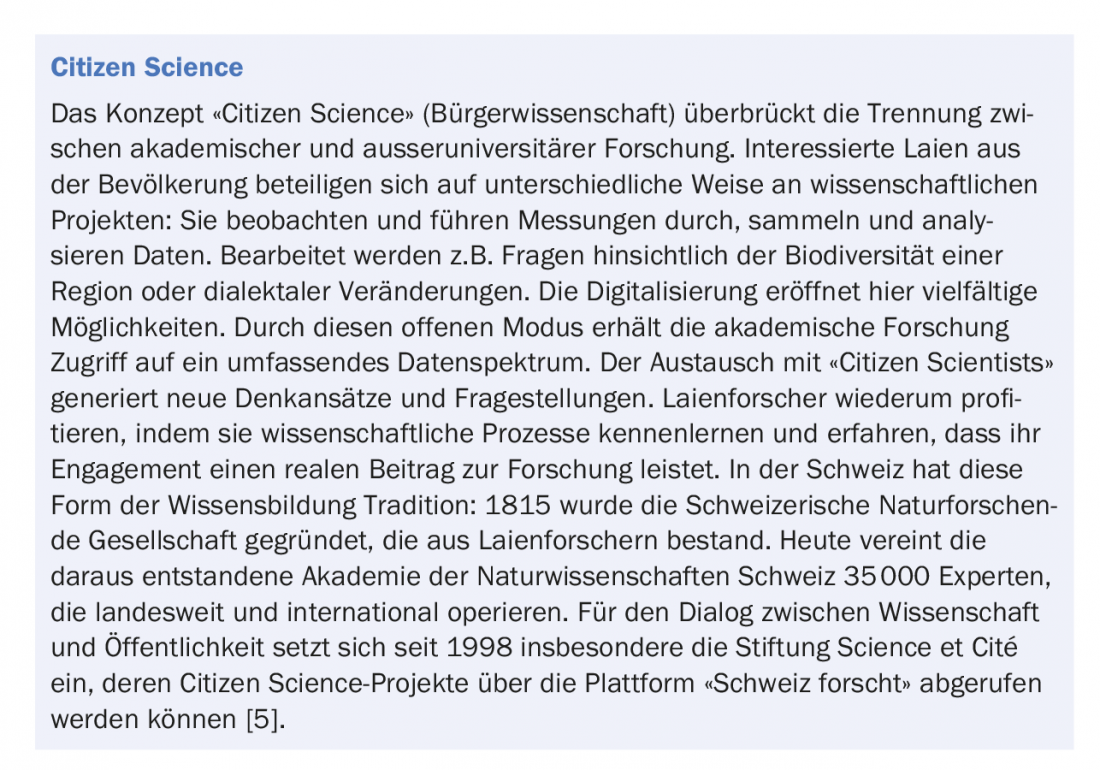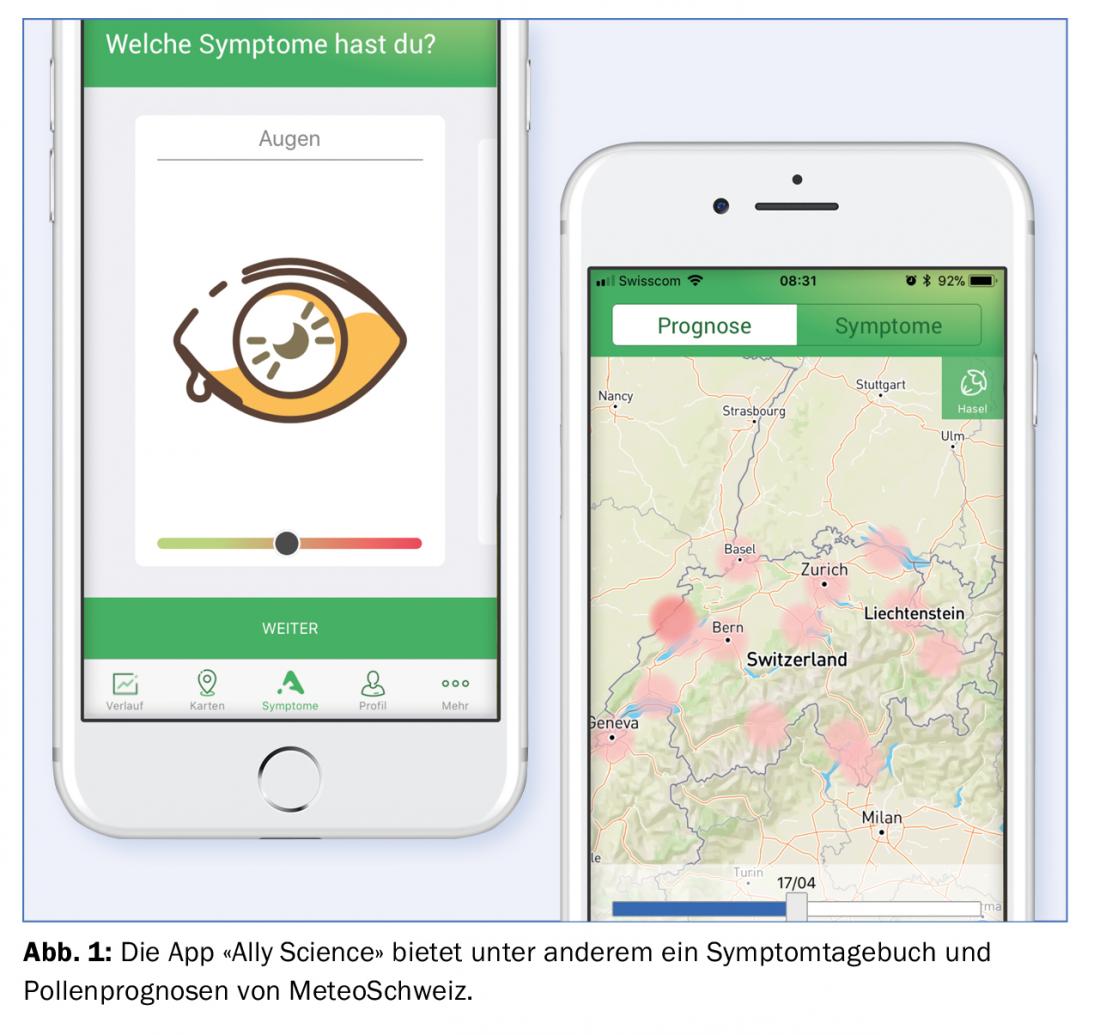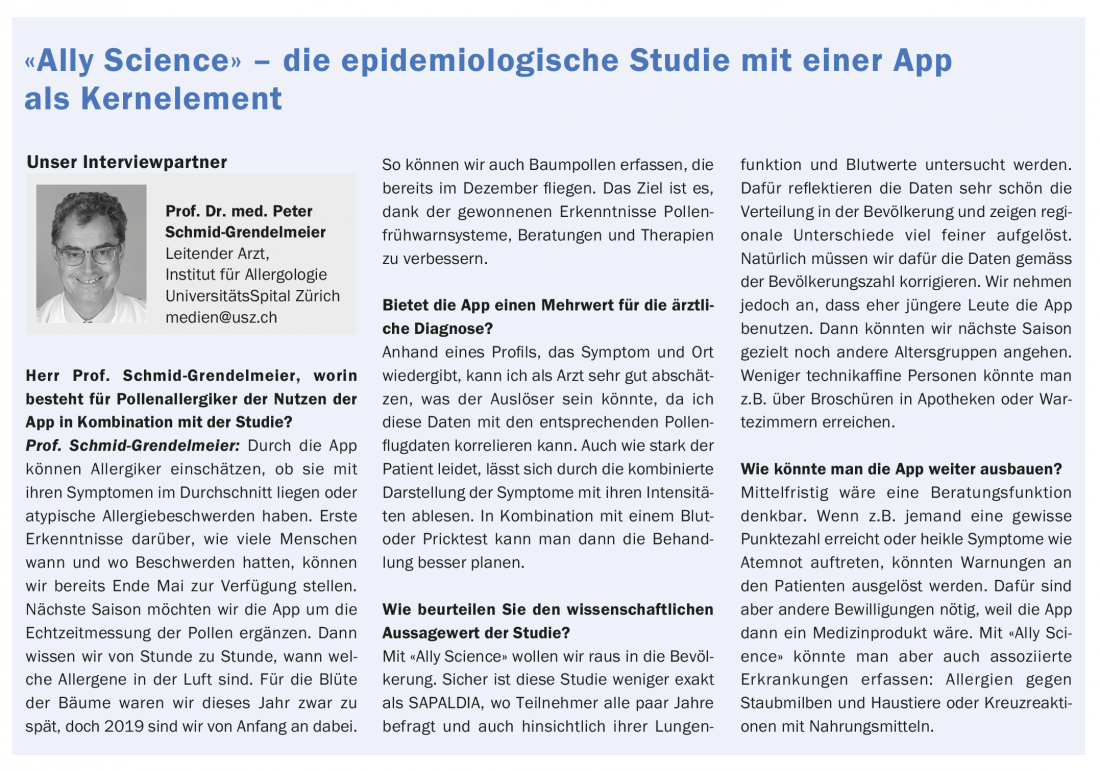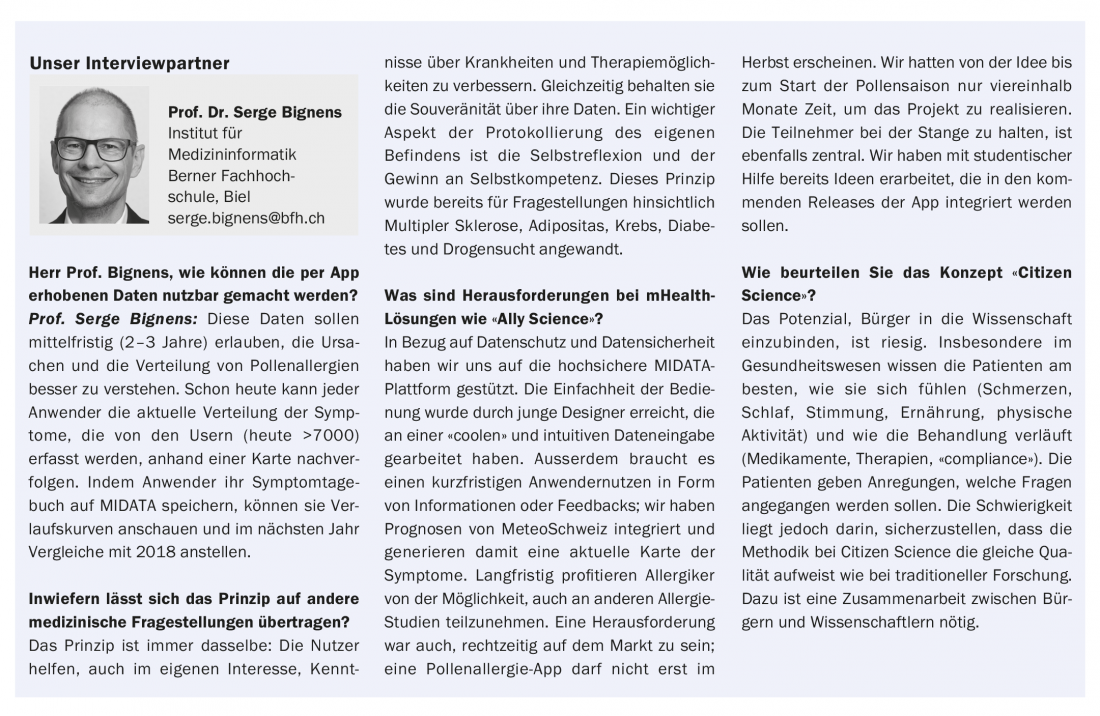Since April, anyone suffering from pollinosis has been able to support the largest study of pollen allergy in Switzerland to date: The “Ally Science” app collects information on symptoms and provides pollen forecasts for those affected. It is the heart of the new epidemiological study and functions according to the principle of “Citizen Science”.
Itching in the eyes and nose, sneezing attacks, rhinorrhea, and restricted nasal breathing are symptoms of allergic rhinitis – the “people’s disease” that affects nearly one in five people in Switzerland. About 20% of the population suffer from the so-called “hay fever”, the pollen allergy (pollinosis) [1]. In this overreaction of the immune system, the proteins of the pollen, which are not dangerous in themselves, are classified as aggressors. The body reacts by producing allergen-specific IgE antibodies, which trigger the familiar symptoms through the release of messenger substances (including histamine) upon renewed contact with the allergen. Although pollinosis often occurs in children and adolescents, in principle it can affect anyone. And the number of people affected is increasing: 100 years ago, their share was just 1% [2]. The causes of this increase are a changed lifestyle with altered microbial contact as well as increased pollution, which affects the aggressiveness of allergenic pollen on the one hand and the sensitivity of the respiratory tract on the other. The report of the FP7-EU project “Atopica” also emphasizes the importance of climate change. The study completed in 2015, which investigated the impact of climate change on pollen allergy, predicts a doubling of sensitization by ragweed pollen in the period 2041-2060 [3]. In view of the increasing number of people affected, research into pollen-associated allergic rhinitis is urgently needed.
New research project on pollinosis
Although pollinosis affects many people, its scientific detection is difficult. “The symptoms are often only mild to moderate,” explains Prof. Peter Schmid-Grendelmeier, MD, head of the allergy ward at the University Hospital Zurich. “You go to the pharmacy and maybe to your family doctor, but rarely to a specialist or hospital. Unlike malignant diseases such as heart disease or cancer, you are not recorded in a study”; according to Prof. Schmid-Grendelmeier, around 70% of patients actually seek care in pharmacies, 25% visit their family doctor and the rest go to a specialist. The Swiss epidemiological cohort study SAPALDIA has been running for 20 years. It is the most important long-term study in Switzerland and investigates the effect of air pollution exposure, lifestyle as well as other environmental factors on the health of the population [4]. Since spring 2018, a new research project has been dedicated specifically to the study of pollen allergy.
The largest research project on pollinosis in Switzerland to date aims to clarify how many people suffer from hay fever and which allergic symptoms are most common. It is also clarified who is already undergoing treatment. To date, it has also not been researched in which regions (cantons, city vs. countryside) symptoms occur particularly strongly and what influence pollen count, air pollution and other factors such as the weather exert. “Switzerland is particularly well suited for this because it has very different topographical conditions in a small area,” explains Prof. Serge Bignens, Institute Director of the Medical Informatics Department at the Bern University of Applied Sciences.
Data collection by means of “Ally Science
A new app is designed to help collect study-relevant data. “Ally Science” was designed and developed by the Bern University of Applied Sciences in cooperation with the IT company ELCA. Also the foundation Aha! Allergy Center Switzerland is involved. With the help of the app, which works on iOS and Android, users are able to record emerging symptoms in a flash. “It was important to us that the app be graphically attractive as well as intuitive,” emphasizes Prof. Bignens; users need less than 20 seconds to make an entry. This is to ensure that the effort remains low and that as many interested parties as possible use the app. After all, the higher the participation, the more meaningful the scientific survey. The application is therefore available in all four national languages and in English.

Ally Science” turns users into citizen scientists (box): As people directly affected, they keep a record of their symptoms. How strongly the eyes burn, whether the nose runs or the lungs whistle can be recorded via a controller. MeteoSwiss provides pollen forecasts that can be consulted via a map. The current load of sycamore pollen in Bern can be seen from the red dots (Fig. 1) . Users can call up their personal symptom history of the last few days via the synthesis function.

Recognize regional differences
Allergenic plants are mainly anemophilic. Allergens are divided into three main groups: Trees, grasses and herbs. In Switzerland, out of more than 3000 plant species, only about 15 pollen species are allergenic. About 70% of allergy sufferers react to grass pollen, and cross-allergies within the main groups are common. Those who show symptoms with birch pollen probably also react to hazel or alder. The pollen season begins as early as January, when the first trees and shrubs bloom. In summer, various grasses are added, and in autumn – some herbs. Therefore, when a person shows symptoms is indicative for an initial determination of allergy. The flowering time of individual plants of a main group depends on the temperature developments of the preceding months and can thus fluctuate; in the case of hazel and alder, pollen production starts between January and March [2]. Thus, some may be plagued by sneezing attacks, while others may not even feel a tickle.
By keeping a symptom diary, app users can track the development of pollen allergic reactions in real time and on a region-specific basis. In cities, for example, the load is noticeably higher. “It’s not necessarily that the pollen content per cubic meter is higher,” Prof. Schmid-Grendelmeier specifies. “But the allergen content is higher, for example, in birch pollen, whose main allergen is a stress protein that the birch produces when it has too little space or water, for example.” These allergenic proteins are also released more frequently as pollen bursts more rapidly in contact with pollutants. Other stress factors are the circulation of air in alleys and mucous membranes irritated by exhaust fumes and viral attacks. The information allergy sufferers gather through “Ally Science” can help with urban planning and planting, among other things.


Anonymously support research
Up to 100,000 allergy sufferers should ideally participate in the study. A few thousand are already there. The data is stored on MIDATA. Individually encrypted, they are stored on the private user account. The platform was co-founded in 2015 by ETH professors Ernst Hafen and Donald Kossmann. It is organized as a nonprofit cooperative and serves to store personal health data. Those who wish can make individual data sets available to medical research in anonymized form. This is made possible by separating the IT platform and mobile applications, which can be offered by research groups, startups or IT service providers. Every MIDATA user can become a cooperative member and contribute to the control and development of the platform. An elected ethics committee reviews whether research projects launched through MIDATA meet data ethics standards.
“MIDATA has already implemented several projects where patients document their health status using a mobile application and make this data available to research,” says Prof. Bignens, “for example in the field of MS or gastric bypass surgery.” With “Ally Science”, the aim is now to involve a larger part of the population in the research – and thus to give the “widespread disease” pollinosis a stronger contour.
Literature:
- Ballmer-Weber B, et al: Allergic rhinitis. A common disease of the 20th century. Swiss Med Forum 2017; 17(8): 179-186.
- Helbling A, et al: Pollen allergy. “Hay fever.” Dossier by aha! Allergy Center Switzerland. November 2017.
- Lake IR, et al: Climate change and future pollen allergy in Europe. Environ Health Perspect 2017; 125: 385-391.
- SAPALDIA: Study Description. 2011. www.sapaldia.ch/de/die-sapaldia-kohorte-menu/studienbeschreibung
- Science et Cité: Switzerland researches. 2018. Available at www.schweiz-forscht.ch. Accessed May 2018.
DERMATOLOGIE PRAXIS 2018; 28(3): 33-36
HAUSARZT PRAXIS 2018; 13(7): 9-12











